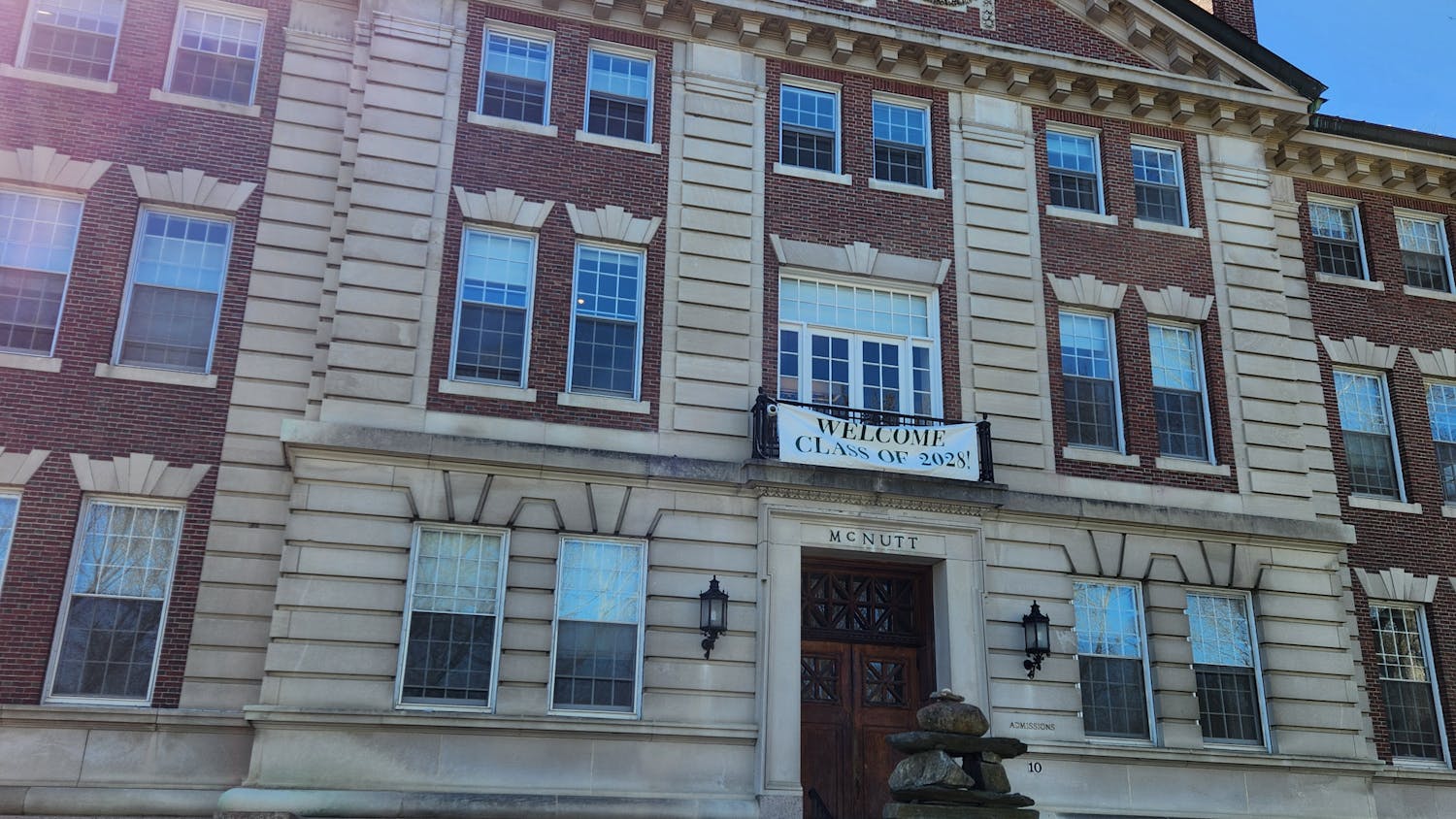At times, 2007 seems like the ancient past. That year, the first iPhone was released, “Harry Potter and the Deathly Hallows” sold 15 million copies in 24 hours and, crucially, archaeologists uncovered a 2,100-year-old melon in Japan. Gender issues were also coming under scrutiny on an enormous scale as Hillary Clinton became a leading presidential candidate. And while the outside world seemed tumultuous, a similar change was implemented in Hanover that would have significant and far-reaching impacts, although on a less massive scale than the possibility of a woman in the White House.
In the winter of 2007, then-dean of residential life Martin Redman said he was made aware, through his position as a senior administrator, that a Dartmouth non-discriminatory policy had recently been updated to include gender identity.
“Quite honestly much of that was simply due to the American public and institutional policies becoming current,” Redman, now the executive director of college houses and academic services at the University of Pennsylvania, said.
Redman also noted that Dartmouth administrators had already been discussing gender in terms of employee benefits.
“Healthcare issues related to same sex partners not being able to acquire health coverage was a big issue nationally in the late ’90s and 2000s,” he explained. “So the College was engaged in that conversation for employees and benefits.”
He also said that the student body expressed desires for support services and living environments not solely based on the “heterosexual norm.”
Redman approached his colleagues at the office of residential life, including director of undergraduate housing Rachael Class-Giguere, with thoughts about making Dartmouth’s housing more inclusive to adhere to the new policy.
“We decided that we had to look at that policy in regard to housing, because we clearly look at gender when making housing assignments,” Class-Giguere said.
Subsequently, a small committee formed to pursue implementing some form of gender-neutral housing on Dartmouth’s campus. The committee included Redman, Class-Giguere, former assistant dean of student life and adviser to lesbian, gay, bisexual and transgender students Pamela Misener and various other administrators and students.
The committee deliberated on offering the option of gender-neutral housing for students whose biological sex at birth didn’t necessarily match with their current gender identity. Rather than making all housing gender-neutral, however, they also sought to maintain single-sex housing for other students.
“We also had students for whom having single-sex housing was very important for cultural, religious or personal reasons, so we didn’t want to completely throw away the gender binary for housing assignments,” Class-Giguere said.
Essentially, she said, they needed to find room for everybody.
The committee liked the idea of a gender-neutral program floor, where people could engage in conversations about gender issues and form a community.
While the inclusion of an affinity-style program for gender-neutral housing seemed like a solution to many of the committee’s concerns, it wasn’t a silver bullet for solving questions of gender and student living. Class-Giguere said that the committee realized that there were people who wanted or needed the option of living in gender-neutral housing but may not necessarily be attracted to the idea of living on a program floor. Again, the committee needed to accommodate the needs of every student, reiterating the need for find room for everyone to be comfortable at Dartmouth.
In addition to concerns about creating affinity housing and students’ possible aversion to such a program, there was also the issue of the D-plan and its effect on student housing to consider.
“If we made too many rooms gender neutral for fall with all occupants agreeing to that and then in winter or spring term had more students returning who did not want that as a housing option, then how would we accommodate them on campus?” Redman said.
Thus, Redman explained, the committee started out slowly, implementing gender-neutral housing on only a few floors in certain buildings, trying to determine student interest before they did anything on a large scale.
Redman noted, however, that none of these obstacles threatened the possibility of having the housing, only the details of how it would materialize.
“I don’t think anyone saw real disadvantages, just logistical issues that needed to be resolved,” he said.
Taking all of this into consideration, the committee decided on forming a gender-neutral program in the ground floor of McLane Hall, and also provided gender-inclusive housing options in different buildings throughout campus.
Today, the possibility of students living together regardless of gender identity has expanded across campus to include the Ledyard apartments, the River apartments, the Lodge, Mid-Massachusetts Hall, Hitchcock Hall, Gile Hall, the East Wheelock cluster and two floors of New Hampshire Hall.
Class-Giguere said she was especially happy to add the Lodge and Mid-Mass to the list of gender-inclusive housing so that sophomores — who generally don’t have apartments or suites — could have the option in addition to the other classes.
“It should be something anyone can have, and not need to ask for special arrangements,” she said.
Buildings and floors other than these few follow policies based on the gender binary.
Class-Giguere said the committee expected there to be at least some controversy over the new housing policies — that people might think it was a bad idea or could be confused on what the housing constituted.
She noted that there were critical responses from two alums who didn’t understand the aims of the program. They thought, she said, that it was a chance for heterosexual couples to live together. While Class-Giguere notes that this is possible, it is not the intent of the program floor or gender-neutral housing in general.
Redman echoed Class-Giguere.
“As a diverse community in all ways, individuals have opinions,” he said. “Not all students were interested in this as a housing option for themselves. Certainly the same would hold true for some students’ parents.”
While there were individuals who seemed to misunderstand the program and its purpose, Redman noted that “‘controversy’ is too strong a word to use.”
Despite a few less-than-favorable reactions, Class-Giguere said that the overwhelming majority of people at Dartmouth were “receptive and happy” about the housing options, and its effects have reached far beyond providing gender-inclusive housing to students.
“I think the discussion about gender identity has continued to evolve and expand,” Class-Giguere said. “More and more people are comfortable discussing these issues, and that’s a great thing.”
Since implementing the gender-inclusive housing, attention to issues around gender and the concerns of LGBT students have continued on campus.
A few weeks after the gender-neutral housing options had been announced — and the applications for thefall housing were due — Dartmouth kicked off its first official PRIDE week at the end of April 2007.
Pam Misener, who sat on the gender-neutral committee, said to The Dartmouth at the time that there was sufficient acceptance of LGBT issues on campus at the time to enable most of the student body to participate in PRIDE week celebrations.
That fall, when the first groups of residents began living in the gender-neutral program floor and gender-inclusive housing, the organization at Dartmouth formerly known as the Gay Straight Alliance was renamed Gender Sexuality XYZ in hope of increasing its inclusivity of all gender identities and sexual orientations.
Furthermore, the past eight years have seen Dartmouth join IvyQ, a pan-Ivy community of LGBT students, hosting the conference for the first time this past fall.
Alongside this has been the founding of various groups for women empowerment and community like Link Up and Women’s Forum and the creation of Dartmouth Spectra, a group that seeks to enhance community among LGBT students by hosting social events.
A particularly noteworthy change was the implementation of the Triangle House, a living learning community with its own house that is centered around fostering discussion and awareness of LGBTQ+ issues and experiences, this past fall.
The Triangle House, however, brought new challenges for original gender-neutral programming. Associate director of the Center for Gender and Student Engagement Michelle Hector explained that the gender-neutral program floor changed its name to the gender-equity program floor this past fall, due to Triangle House’s creation.
“The name was changed with the construction of Triangle House to highlight the different focus of each of the living learning communities,” Hector said.
The current gender-equity floor UGA, Gustavo Mercado Muñiz ’16, explained that the floor revamped this past fall to help distinguish it from Triangle House.
“We had to step up our game,” Mercado Muñiz said. “This term there’s more of an involved discussion. Residents are leading floor meetings [and] attending conferences about gender. There are higher expectations.”
Mercado Muñiz did note that the floor’s popularity in recent years could be somewhat attributed to the fact that the floor guarantees nice housing.
Founder and co-chair of Spectra Andrew McKee ’15 said that he never thought about living on the gender equity program floor, instead opting to live in the Triangle House.
“I wanted to live with people with an LGBTQ affiliation,” he said. “Just because the floor is gender-neutral doesn’t mean everyone on it will be LGBTQ-affiliated.”
Kristen Chalmers ’17, who began living on the gender-equity floor this winter, said that floor has a much stronger sense of community than other halls that only include upperclassmen.
“Having weekly meetings helps foster the sense of community,” Chalmers said.
Kelsey Weimer ’16, who lives on the gender equity program floor, said that one of the reasons she applied to live on the floor is because she wanted “a healthy dose of socially aware conversations.” Weimer praised affinity housing as a whole.
“In general affinity floors are really great and really beneficial for their respective student populations,” she said. “It’s also amazing to live in a mixed-gender floor, and something from which a lot of people can learn.”
Mercado Muñiz, who said that he has been questioning his own gender identity for a while, said that being a UGA on the floor has enhanced his own Dartmouth experience.
“Finding this floor has given me a place within the normally hectic Dartmouth life to fully question what it means to be male and to present as male,” Mercado Muñiz explained.
It’s clear that whether anticipated or not, the housing’s implementation has fanned out to affect Dartmouth in several ways.
“A lot more people than the College originally thought are interested in and affected by these topics, and having that space has definitely helped to increase visibility of gender issues on campus,” Mercado Muñiz said. “[It] has especially helped in terms of creating a safe space for those who don’t identity as male or female.”




